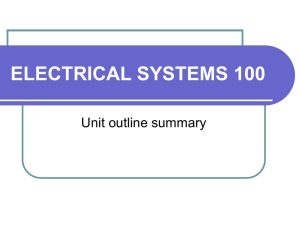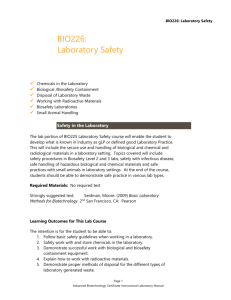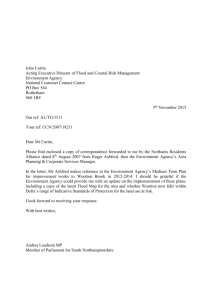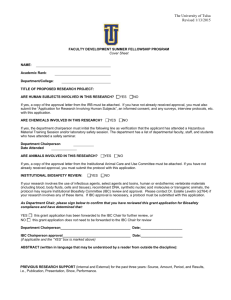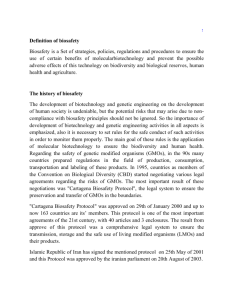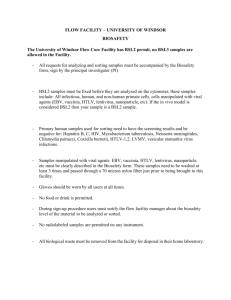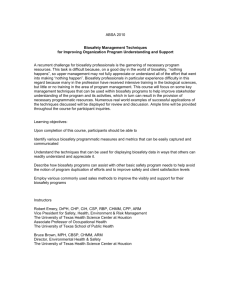Please use this checklist before your initial procurement of a new
advertisement
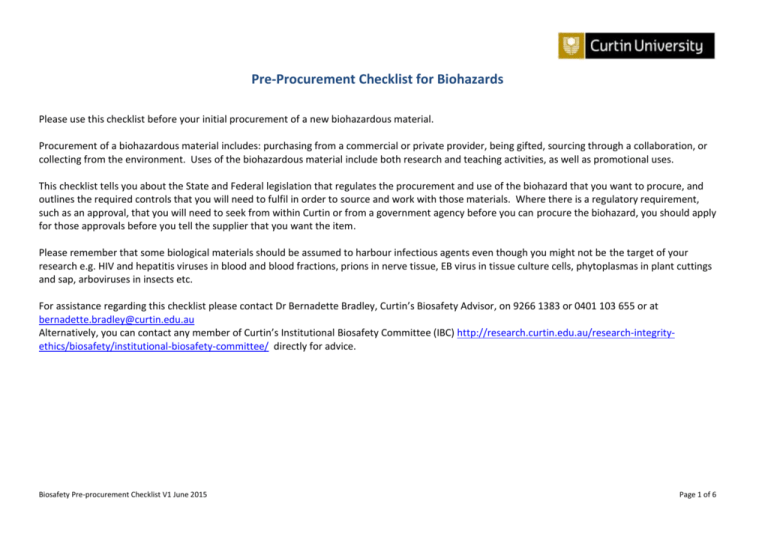
Pre-Procurement Checklist for Biohazards Please use this checklist before your initial procurement of a new biohazardous material. Procurement of a biohazardous material includes: purchasing from a commercial or private provider, being gifted, sourcing through a collaboration, or collecting from the environment. Uses of the biohazardous material include both research and teaching activities, as well as promotional uses. This checklist tells you about the State and Federal legislation that regulates the procurement and use of the biohazard that you want to procure, and outlines the required controls that you will need to fulfil in order to source and work with those materials. Where there is a regulatory requirement, such as an approval, that you will need to seek from within Curtin or from a government agency before you can procure the biohazard, you should apply for those approvals before you tell the supplier that you want the item. Please remember that some biological materials should be assumed to harbour infectious agents even though you might not be the target of your research e.g. HIV and hepatitis viruses in blood and blood fractions, prions in nerve tissue, EB virus in tissue culture cells, phytoplasmas in plant cuttings and sap, arboviruses in insects etc. For assistance regarding this checklist please contact Dr Bernadette Bradley, Curtin’s Biosafety Advisor, on 9266 1383 or 0401 103 655 or at bernadette.bradley@curtin.edu.au Alternatively, you can contact any member of Curtin’s Institutional Biosafety Committee (IBC) http://research.curtin.edu.au/research-integrityethics/biosafety/institutional-biosafety-committee/ directly for advice. Biosafety Pre-procurement Checklist V1 June 2015 Page 1 of 6 Biohazardous material Animals Samples taken from humans or animals (for example: blood, sputum, tissue, urine, faeces, etc) An Australian native animal, or samples/parts from an Australian native animal (for example: fish, Regulatory requirements WA Animal Welfare Act (2002) Australian code of practice for the care and use of animals for scientific purposes (7th edition 2004) National Health and Medical Research Council Act (1992) The National Statement on Ethical Conduct in Human Research (2007) WA Animal Welfare Act (2002) Australian code of practice for the care and use of animals for scientific purposes (7th edition 2004) Wildlife Conservation Act (1950) Fish Resources Management Act (1994) Biosafety Pre-procurement Checklist V1 June 2015 What you need to do before procurement Apply for approval from Curtin’s Animal Ethics Committee http://research.curtin.edu.au/research-integrity-ethics/animal-research-ethics/ . Check if you need to apply for approval from Curtin’s Human Research Ethics Committee or Animal Ethics Committee http://research.curtin.edu.au/research-integrity-ethics/humanresearch-ethics/ . Handle the samples as at least Risk Group 2, within a Class II Biosafety Cabinet inside a PC2 facility, unless they are known to contain microorganisms from RG3/4. For information about how to handle the samples, refer to AS/NZS2243.3:2010 (the Australian/New Zealand Standard 2243.3:2010 can be accessed by searching the library databases http://databases.library.curtin.edu.au/ for ‘Standards Australia online premium’, and then searching the SAI Global database for ‘2243.3’) and http://www.safeworkaustralia.gov.au/sites/SWA/about/Publications/Documents/263/Natio nalCodeOfPractice_Control_WorkRelatedExposure_Hepatitis_HIVViruses_NOHSC20102003_PDF.pdf . If you are able to handle your samples in this way then you do not need to seek IBC approval to do this work. However, if you can’t comply with these two documents for any reason, or you are not sure, then please contact the Biosafety Advisor, who will help you to seek IBC assessment and approval before you can begin work. Samples from humans can infect you with diseases that those people carried. Samples from animals can infect you with zoonotic diseases that those animals carried. Please see the linked document about zoonoses for more information http://www.dpi.nsw.gov.au/biosecurity/animal/humans/zoonoses-transmission . It is recommended that you get the appropriate immunisations listed in The Australian Immunisation Handbook 9th Edition 2008 http://www.immunise.health.gov.au/internet/immunise/publishing.nsf/Content/Handbook 10-home . There may be other vaccinations available that are relevant to the samples you are handling. Consider the requirements for a fauna licence http://www.dpaw.wa.gov.au/plants-andanimals/licences-and-permits/134-fauna-forms or a fish/crustaceans licence http://www.fish.wa.gov.au/Pages/Home.aspx . Page 2 of 6 vertebrates, insects, invertebrates, fur, skulls, feathers, carcasses, bones, scats) Australian native plants, or parts of an Australian native plant (for example: algae, flowering plants, and nonflowering plants, seeds, flowers, leaves, branches, roots) A poisonous/toxic plant A weedy plant listed on the Department of Agriculture and Food's Declared Plants List? (search for “Declared Plants List” on the DAFWA website http://www.agric.wa.gov.a u/) Biting/stinging or venomous/toxic invertebrates (for example: bees, ants, jellyfish, coral) Insects that are able to act as vectors for human, animal and plant disease (for example: mosquitoes, ticks, thrips) Wildlife Conservation Act (1950) Biosafety Pre-procurement Checklist V1 June 2015 Consider the requirements for a flora licence http://www.dpaw.wa.gov.au/plants-andanimals/licences-and-permits/135-flora-licences . Seek assessment of your handling methods from Curtin’s Institutional Biosafety Committee. Plants on the Declared Plants List must be handled following the guidelines on the List. You must not release a pest plant into the environment. Seek assessment of your handling methods from Curtin’s Institutional Biosafety Committee. Please consult Section 3 of the AS/NZS2243.3:2010 ( the Australian/New Zealand Standard 2243.3:2010 can be accessed by searching the library databases http://databases.library.curtin.edu.au/ for ‘Standards Australia online premium’, and then searching the SAI Global database for ‘2243.3’) to identify the Risk Group that those insects should be handled at, and handle them using the appropriate Physical Containment level (Section 5 of the AS/NZS2243.3:2010). If you are able to handle the insects at the same PC level as their RG then you do not need to seek IBC approval to do this work. However, if you can’t comply with these two sections of the Standard for any reason, or you are unsure, then you will Page 3 of 6 need to contact the Biosafety Advisor, who will help you to seek IBC assessment of your handling methods, and approval before you can begin work. Microorganisms in Risk Groups 2, 3 or 4 (to find the Risk Group of your microorganism, refer to Section 3 of the Australian/New Zealand Standard 2243.3:2010. It can be accessed by searching the library databases http://databases.library.cur tin.edu.au/ for ‘Standards Australia online premium’, and then searching the SAI Global database for ‘2243.3’) Security Sensitive Biological Agents (SSBA) Abrin (reportable quantity 5 mg), Yersinia pestis (Plague), Bacillus anthracis (Anthraxvirulent strains), African swine fever virus, Botulinum toxin (nontherapeutic forms, reportable quantity 0.5 mg), Capripoxvirus (Sheep pox virus and Goat pox virus), Ebolavirus, Classical swine fever virus, Foot-and-mouth disease virus, Francisella All microorganisms in Risk Groups (RG) 2, 3 or 4 need to be handled at the appropriate corresponding Physical Containment (PC) level (e.g. PC2 for RG2). For information about how to handle the samples, refer to Sections 3-5 of the AS/NZS2243.3:2010. If you can handle your microorganism at the same PC level as their RG then you don’t need IBC approval. This includes handling the microorganism entirely within a Class II Biosafety Cabinet if it can be infective via the respiratory route. However, if you need to use non-Standard methods, then please contact the Biosafety Advisor, who will help you to seek IBC assessment of your methods, and approval, before you can begin work. A second control may be vaccination. National Health Security Act (2007) – Part 3 Biosafety Pre-procurement Checklist V1 June 2015 Contact the Biosafety Advisor bernadette.bradley@curtin.edu.au (0401103655 or 92661383) and the Chair of Curtin’s Institutional Biosafety Committee d.groth@curtin.edu.au immediately. Page 4 of 6 tularensis (Tularaemia), Highly pathogenic influenza virus infecting humans, Clostridium botulinum (Botulism, toxin-producing strains), Marburgvirus, Lumpy skin disease virus, Ricin (reportable quantity 5 mg), Peste-des-petitsruminants virus, Rinderpest virus, Salmonella Typhi (Typhoid), SARS coronavirus, Variola virus (Smallpox), Vibrio cholerae (Cholera, serotypes O1 and O139 only), Yellow fever virus (non-vaccine strains) Any environmental or biological specimen likely to contain an SSBA (see above) that you are planning to culture microorganisms from (for example: from soil, wastewater, manure, animal carcasses, human excreta) A genetically modified organism GMO (GMOs include many commercially available and gifted: cell cultures, mouse models, clones, microorganisms containing National Health Security Act (2007) – Part 3 Contact the Biosafety Advisor bernadette.bradley@curtin.edu.au (0401103655 or 92661383) and the Chair of Curtin’s Institutional Biosafety Committee d.groth@curtin.edu.au . Gene Technology Act (2000) Apply for approval from Curtin’s Institutional Biosafety Committee by following the steps on this website http://research.curtin.edu.au/research-integrity-ethics/biosafety/genetically-modifiedorganisms/ . Biosafety Pre-procurement Checklist V1 June 2015 Page 5 of 6 constructed plasmids, and viral vectors.) Biological material or soil/sand/rocks imported from overseas Biological material or soil/sand/rocks transported from the Eastern States into Western Australia Quarantine Act 1908 (Commonwealth) Biosecurity and Agriculture Management Act 2007 (State) Biosecurity and Agriculture Management Act 2007 and Regulations (State) Biosafety Pre-procurement Checklist V1 June 2015 The Biosafety Advisor bernadette.bradley@curtin.edu.au (0401103655 or 92661383) will help you to figure out if you need quarantine Import Permits from either or both Federal and State Departments of Agriculture. The Biosafety Advisor bernadette.bradley@curtin.edu.au (0401103655 or 92661383) can help you to figure out if you need a quarantine Import Approval from the State Department of Agriculture and Food. Page 6 of 6
